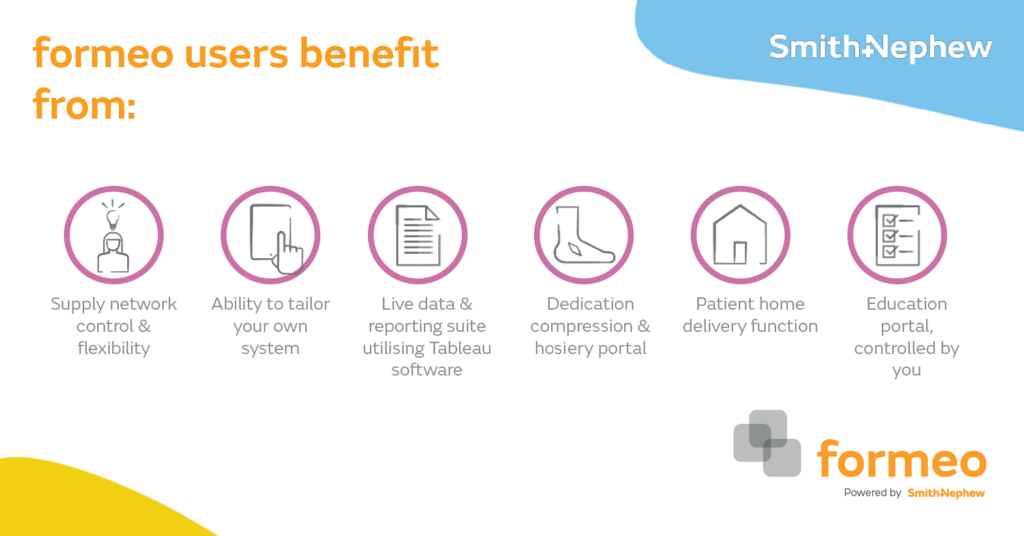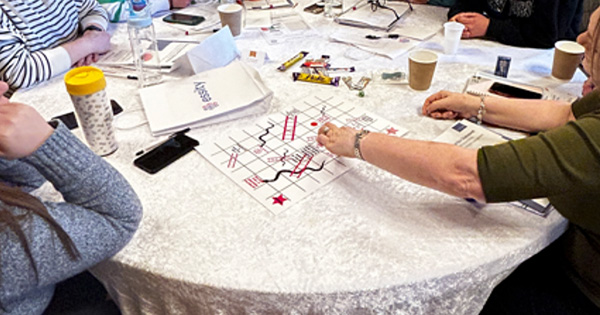This article is based on a Made Easy workshop held at the Wounds UK Annual Conference in Harrogate, UK on 7th November 2023, sponsored by Smith+Nephew. The aim of the workshop was to give an overview of the advantages of using a continuous improvement approach in wound care. Understanding the wound care service is crucial when seeking to identify areas that could benefit from improvements. Effective data capture methods and clinical practice examples demonstrated how easy it is to measure patient/wound outcomes for any practice changes that are implemented. The workshop was presented by Kerry Carmichael, Jonathan Nye, Lauren Roughton and Grainne Ulyatt.
Continuous improvement is a cycle of reviewing, making small incremental changes in practice and then reassessing the quality of care provided to patients. For continuous improvement to be successful, established and fully understood, criteria needs to be applied across the whole process. An important factor that can adversely affect this process is lack of consistent terminology in clinical practice.
An abundance of varied terms for the same concept can lead to confusion among healthcare professionals. Furthermore, an abundance of synonymous medical terms can complicate training and education, patient assessment and patient understanding. For instance, the term ‘chronic’ may imply a lifelong condition and, therefore, the patient might start perceiving their wound as incurable. The Best Practice Statement on Active treatment of non-healing wounds in the community (Wounds UK, 2022) discusses the importance of encouraging language during training and when supporting colleagues and patients involved in their wound healing journey, as this frames wound healing as a real possibility.
To demonstrate how differences in terminology can affect potential variations in practice, delegates were asked to describe the healing status of the wound presented to them [Figure 1], which historically has seen many interchangeable words to describe the same process such as ‘static’, ‘stalled’, ‘macerated’ and ‘stagnant’ to name a few. Ultimately, inconsistent clinical practice means inconsistent results. Quality and cost problems in a process or product due to variation and poor outcome predictability and results were also highlighted as reasons why continuous improvement is of importance.
So, how can we identify and overcome variations in practice? Audits provide a benchmark to begin focusing on change and are used in clinical practice to facilitate the continuous improvement cycle. Clinical practice audits are a systematic and structured way of collecting data, helping to assess whether patients are receiving the most up-to-date quality of care, highlight where variations in care may be and identify where change is best placed. Once an audit is complete and the results have been analysed, this is an ideal time to implement a supporting evidence-based clinical pathway that can be validated locally within the continuous improvement cycle. Evidence-based clinical pathways will ensure clinicians are aligning care and treatment options and lead to patients receiving optimum treatment.
Audits are an ongoing process and will still be carried out thereafter to enable continuous review and reassessment, allowing clinicians to practice up-to-date methods and for patients to receive the best treatment options. They can also confirm the effectiveness of improvements that were implemented based on findings from previous audits.
NHS England
The delivery and continuous improvement review was carried out in April 2022 to consider how the NHS can develop a culture for continuous improvement, while focusing on its most pressing priorities (NHS England, 2023). The review team explored how we ‘improve with purpose’, using all the assets at our disposal: data and evidence, digital transformation and the skills and experience of our health and care workforce. The review team made 10 recommendations which were endorsed by NHS England’s Executive Group (outlined in the report). NHS England’s Board then consolidated these recommendations into three actions:
- NHS improvement approach — by working in partnership, all NHS providers within their integrated care boards will embed quality improvement to improve health outcomes
- Leadership for improvement programme — share common principles to enhance the performance of processes and systems
- National improvement board — to improve performance and outcomes whilst reducing unwarranted variations in care.
Clinical practice example — data collection, analysis and implemented change
Kerry Carmichael went on to discuss an original audit that was carried out in Hull and East Riding community nursing teams and treatment rooms in 2019 with support from Smith+Nephew. The original audit identified areas requiring change; the re-audit demonstrated the benefits of aligning the stock management process with clinical pathways that had been successfully embedded into practice (Styche, 2019).
The first area that was identified for improvement in the audit was obtaining dressings — it was established that there were different methods of obtaining dressings across different areas, which led to variations in not only budget and spend patterns but also wound care practice. Clinicians also carried the burden of counting stock, ordering and then unpacking boxes, which took them away from patient-facing clinical work. To overcome this, a standardised stock management process was implemented across all areas. Stock managers now oversee the process, freeing up clinician time that is well needed when the demands on community nursing teams is ever increasing.
Kerry explained that some of the areas covered in East Riding are quite rural and travelling to reach a base or treatment room in order to get stock was time-consuming. Through the data collected by FORMEO, a web-based non-prescription ordering service, provision of dressings could be tailored to suit each geographical area. This prevented clinicians from travelling unnecessarily for extra stock, which in turn aided staff motivation and engagement and promoted continuity of care.
Technology and innovation in wound care was embraced with the use of FORMEO and clinical pathways were implemented. For user benefits of FORMEO, see Figure 2. The data collected through FORMEO helped to challenge certain areas (e.g. areas that may have a high antimicrobial spend, so training can be revisited) and allowed training to be targeted in specific areas.
It also helped with protected time for learning as, ultimately, if a clinical pathway is to be implemented, staff need to be offered support with education and training. Kerry clarified that a training package was provided to clinicians to highlight the importance of implementing clinical pathways as a tool to support their skills and not to replace their clinical autonomy.
Impact on wound care delivery
To roll out non-prescription, it is necessary to understand what is wrong with the current prescription process with dressings. Data taken from a Smith+Nephew national survey (Styche, 2019), where 517 responses were received up to December 2021, showed that nurses were spending on average 2.3 hours each week chasing/collecting prescriptions, leading to an average waiting time for a prescription wound care dressing of about five days.
Getting the patient in the right product at the point of care is vital — 79% of nurses have reported that not having access has negatively affected patient outcomes, 76% reported delayed healing and 77% reported extra dressing changes.
Wound Management Digital Systems to track and analyse wound healing progress and outcomes are essential and the way forward. However, Kerry noted that this is where challenges were faced as many existing systems do not communicate with each other seamlessly and, therefore, to be successful, systems need to support a clinician’s day-to-day work. A trial with the WOUND COMPASS Clinical Support App, a comprehensive digital support tool for healthcare professionals that aids wound assessment and decision-making to help reduce practice variation, is soon to take place in Kerry’s area.
A key message to take away from this workshop was to ensure you collect the data you want (i.e. what needs to be implemented), be led by that data and feed it back to those who can embed changes into clinical practice. Lastly, Kerry discussed the non-healing wounds project recently embarked upon. This project involves the PICO Single Use Negative Pressure Wound Therapy Non-healing wound clinical practice pathway [Figure 3], which Kerry clarified has helped to change clinical practice. The clinical pathway aims to enable non-healing wounds to progress towards healing but has, in turn, given clinicians the confidence to apply negative pressure at the beginning of the patient’s journey where appropriate, whereas usually this has been the last resort when all else has failed. In turn, this leads to cost and resource savings, releasing nursing time and improved quality of life for the patient.
To conclude this workshop, it was noted that a system should align with the following:
- Reduce cost — reduced overall dressing costs via framework pricing; reduce product usage across the system; reduce total system costs across health economy
- Improve outcomes — access to live data and reporting to drive outcomes; reduced prescription errors and improved use of appropriate wound care products; reduced practice variation due to improved formulary compliance
- Free up clinical time — reduce healthcare professional time that’s currently locked in non-clinical admin; decrease in number of prescriptions generated locally; one wound care portal
- Improve quality of care — faster access to the right product at the point of care; reduced variation; formulary compliance; access/support with education and clinical pathways.





